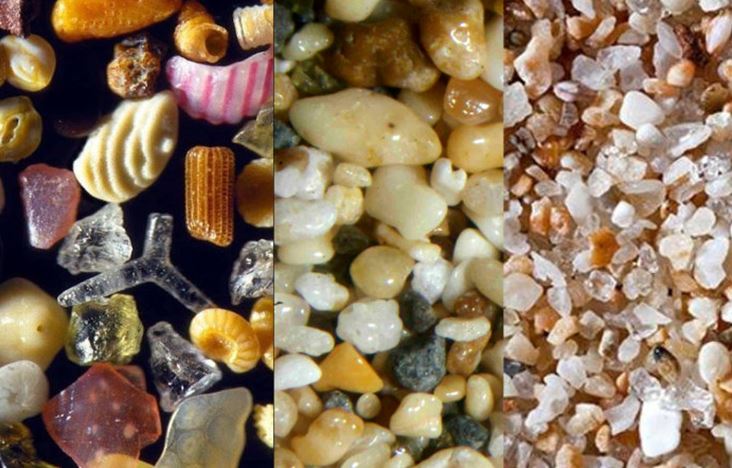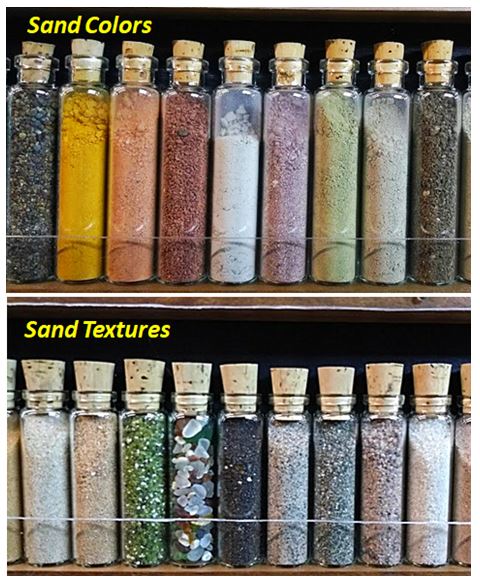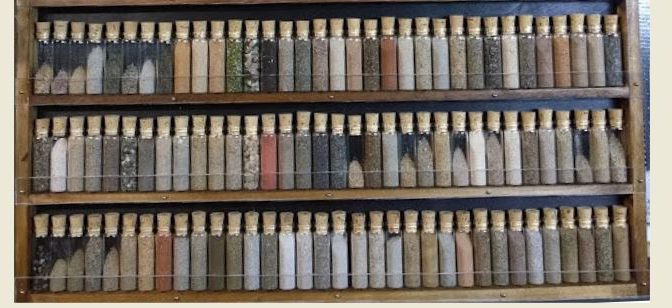Wayne County Gem and Mineral Club member Jim Rienhardt collects sand. In the November WCGMC Newsletter he tells us how and why. I thank him for letting me republish the article here.
by Jim Rienhardt:
Rock to sand to rock: Rock collectors collect on both ends. So do I, but I also collect from the middle – the sand. And, I am not alone. There are many, many people who collect sand and have tens of thousands of samples. But why, isn’t sand uninteresting? The same may be said by someone who doesn’t understand collecting rocks.
All of it tells a story. Chances are that the rock and mineral pieces started out somewhere far away. A book by Michael Welland, ”Sand, The Never-Ending Story”, traces the journey of a grain of sand from the ice age in the Adirondack Mountains to the Chesapeake Bay and on to the Atlantic Ocean. Another book to consider is “A Grain of Sand: Nature’s Secret Wonder” by Gary Greenberg. The three dimensional microphotography of sand in this publication is fantastic.

Sand viewed as a whole in any one place has a particular color and texture. When samples of these sands are brought together and displayed the differences are obvious: from white through the rainbow to black in color, from very fine-grained to coarse. Some collectors also collect what someone familiar with the nomenclature would not classify as sand. Geologists define sediments based on grain size using the Wentworth Scale. Material between 1/16th of a mm to 2mm in diameter are defined as sand-sized particles. Smaller particles are called silt, and larger ones are called gravel. To “officially” be a sand deposit, over 80% of the grains present should fall into the sand size range, however, the grain sizes can be very different in any sample and the sand can be classified further by how well sorted it is. Silt and small pebbles (up to 5mm) samples are also collected, making the collection more diverse – and more interesting.
While most sand collectors start out with samples from their travels, eventually they discover other collectors and begin trading. Along with what friends bring from travels and the trades, a collection begins to grow and can become quite large. A magically growing collection is not news to rock and fossil collectors. The difference is that the sand samples take up less space and are easier to display. Avid collectors have thousands of samples and may have whole rooms devoted to their collections.

Like my collection, some collectors use all consistent sized containers and display them on shelves or custom built racks. Others use random bottles and jars. Some of the most creative displays I have seen are shadow box frames with a picture of the collection site and sand with shells or stones from the same place. Others may use flat coin boxes and store them in drawers.
Unlike rocks and minerals, sand is not sold. Collectors are adamant that sand samples be traded, not sold, and anyone suggesting selling sand in one of the many Facebook groups is quickly chastised. Some active sand collector Facebook groups are Sand Collectors United, Sand Collectors, and Sand Swappers Only. Check these groups to see how active they are and view examples of some collections. There are also many websites devoted to the hobby of sand collecting. On the web visit: http://www.sand-atlas.com, (The Sand Atlas) or https://sandcollectors.org, The International Sand Collectors Society.
A German collector with over 7000 samples has a wonderful website: https://www.sand.world/sand-sammlung/index. Be sure to click “EN” in the upper right corner for the English version of the site. There are many more, but these will give a good idea of how extensive the hobby is and how diverse sand can be. Some of the more interesting samples you may see are pictures of glass sand and star sand.
In contrast to trying to ship quantities of rocks, shipping sand domestically is simple enough. Small plastic bags containing the usual trade amount of 30 ml can be stuffed into USPS Priority Mail boxes and shipped for a very reasonable price. International rates, even to Canada, are, however, expensive. The same box shipped within the US for $7 is $24 to send out of the country. Regardless of the cost, avid collectors are willing to spend a fair amount on shipping to expand their collection. My first box in the mail contained about 20 samples from a collector in Canada who sent them just to help get me started.
My modest collection only contains 260 samples currently. This grows by leaps now and then when I receive a package from a collector friend in Washington State or Portugal. My nephew, who I inspired to start collecting, says he has another 270 samples for me! Time to build a new display case!
Sand is everywhere. Beaches may be the first thought, but sand mounds and sand mines are abundant also. I found a sand deposit across the road from Raquette Lake in the Adirondacks that appeared to be a glacial kame that was primarily granite sand in composition.

Keep sand collectors in mind when traveling. Collect a cup full or so and put it in a Zip-locTM bag with collection site information. I would be glad to take it off your hands, unless you get the sand bug yourself.
